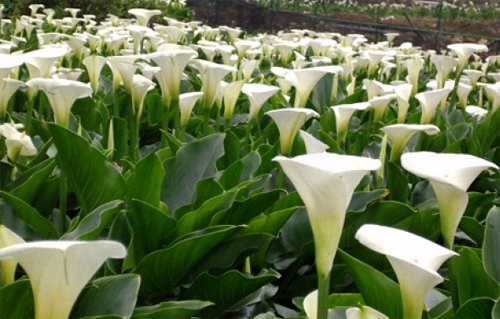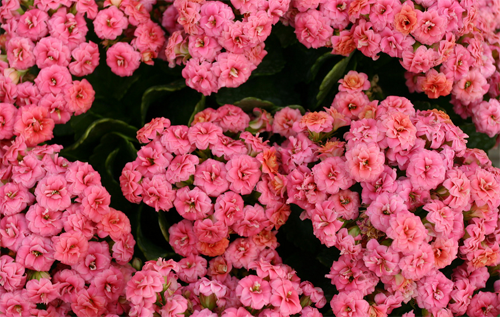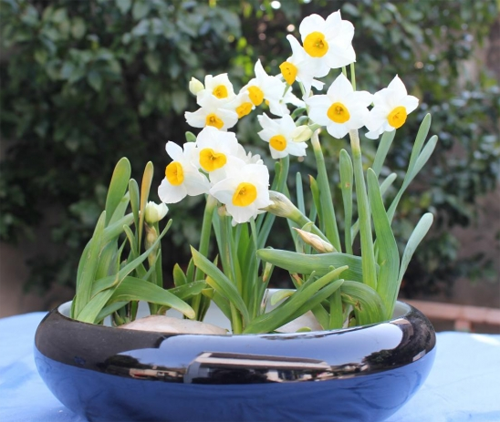How to do the yellowing of leaves in the culture method of sea taro?
Sea taro is now a very popular potted plant, the leaves of sea taro are very large, or very smooth, but how to raise sea taro? Why did the leaves turn yellow in the process of breeding? Let's talk to the Women's Network to see how to solve these problems:

The culture method of sea taro:
1. Soil: taro cultivation is relatively extensive, potted with rotten leaf soil, peat soil or fine sandy soil. when the soil is loose, fertile and sufficient base fertilizer, the leaves are hypertrophic and emerald-green.
2. Watering: in winter, sea taro should be placed on the indoor south windowsill, watering should be controlled, no dry water should be irrigated, fertilizer should be stopped, and the leaves should be sprayed once every 5-7 days with water close to the indoor temperature, so that the leaf color can be kept dark green. As long as the air is moist, the light is suitable, and the nutrients are sufficient, the leaves will be large and stretched, and the ornamental value will be high.
3. Sunshine: sea taro is not allowed to be exposed to the sun. It needs shade from June to October to cover 50-70% of the sun. Although sea taro likes to grow in a semi-shady environment, it has been placed in living rooms and bedrooms for a long time. Due to lack of light, it has a great impact on plant life activities. The formation of many plant organs is directly related to light intensity. Lack of light or no light, plant internodes are particularly long, leaves are underdeveloped and small, lack of chlorophyll and show yellow.
4. Temperature: the suitable temperature for the growth of sea taro is about 20-25 ℃. If the room temperature is kept above 8 ℃ in winter, it can survive the winter safely, and the low temperature is easy to suffer cold damage.
5. Fertilization: sea taro needs to apply dilute liquid fertilizer which is mainly nitrogen fertilizer and mixed with phosphorus and potassium fertilizer once or twice a month in the growing season. In the pot, the application of ferrous sulfate can make the sea taro leaves bigger, thicker, green, smooth and shiny, and the petiole is not easy to elongate, so as to ensure the beauty of the leaves. At the same time, it can promote the formation of buds and prolong the florescence.
6. Insect pests: the common disease of sea taro is Botrytis cinerea. Spray control at the initial stage of the disease can choose 1500 times solution of 50% Nongliling wettable powder and 1500 times liquid of 50% prohydantoin wettable powder and so on.
What if the sea taro leaves turn yellow?
1. Too much light
Too much light is one of the common reasons for the yellowing of taro leaves. Amorphophallus likes shade, 50% shading is needed in summer, and direct sunlight can not be allowed, otherwise the leaves are prone to yellow edge phenomenon. Prevention and control skills: put the sea taro in the home where you can avoid strong light.
2. Lack of light
The yellowing of leaves will also occur when the taro is in a dark place for a long time, mainly because of the lack of light, which affects the photosynthesis of the taro. Prevention and control skills: sea taro avoid strong light, but do not need light, but need sufficient astigmatism, you can put sea taro in a place that avoids strong light but can provide enough astigmatism.
3. Overwatering
Too much watering of sea taro will cause the roots to rot and the leaves turn yellow. Prevention and control skills: sea taro watering should be appropriate, watering should be thorough, but stagnant water should not occur.
4. The page is dusty.
The leaves of Amorphophallus are relatively large and easy to accumulate dust. if they are not washed with water for a long time, the accumulation of dust will hinder photosynthesis. As a result, it is difficult to turn yellow and wither. Prevention and control skills: to regularly spray water to wipe the leaves of sea taro, do not accumulate too much dust.
These are the culture methods of sea taro, if the leaves are really yellow, look for the above reasons, find the reasons, and then correspond to the solution.
What if the leaves of sea taro turn yellow, apply thin fertilizer / replenish water / shade
The sea taro flower is a perennial herb of the Araceae family, which is highly ornamental and can be seen all over the country. However, if the plants in the United States turn yellow, it will also affect their overall aesthetic feeling. What about the yellowing leaves of the sea taro flowers? What is the reason and how to solve it? Next, the editor will take you to learn about it.
First, sea taro leaves yellowing how to do, find the reason
Want to know the sea taro leaves yellowing how to do, first of all, we have to find the reason, to know what is the cause of the leaves yellowing, so that we can carry out targeted treatment. Such as improper watering, insufficient humidity, diseases and insect pests are the causes of this phenomenon, as for how to solve, described in detail below, let's take a look at it.
Second, the reasons for the yellowing of taro leaves (with solutions)
1. Improper fertilization
Fertilizer is one of the main nutrients in the growth of sea taro flowers. If we apply too little fertilizer or the concentration of fertilizer is too high, it will cause the leaves of sea taro flowers to turn yellow. If it is fertilized too little, it will turn yellow due to lack of nutrients, and if the fertilizer concentration is too high, it will burn the plant and cause yellowing.
Solution: the demand for fertilizer in the growth process of sea taro is very high, especially after entering the growth period, its demand for water is very high, basically every other week to apply fertilizer, so that its leaves can grow big. However, the concentration of fertilizer should not be too high when fertilizing, and must be diluted with water before application. If the concentration is too high, it is easy to burn the plant.
two。 Water deficiency
The sea taro flower this kind of plant prefers the warm and humid environment, so the water is very important to it, but how much is watered is the point that we need to pay attention to, if it is watered too much, it will cause its root system to be unable to breathe. as a result, the leaves yellowed, and if too little watering will cause the plant to dry and yellowing.
Solution: if we cause stagnant water when watering taro flowers, we must clean up the stagnant water in time, as long as the problem is generally not very big. If the leaves of taro flowers turn yellow because of drying, we can spray more water on the leaves to maintain the humidity of the environment.
3. The light is too strong.
Amorphophallus likes to grow in a warm environment and is less resistant to direct sunlight. In the process of breeding it, if the light is too strong, it is easy to burn the plant, resulting in the problem of yellowing of taro leaves.
Solution: in the process of cultivating taro flowers, it is best to put them in a place of sunlight scattering to avoid direct sunlight, and when the summer light is relatively strong, we can keep them indoors in the semi-shade. so as not to burn the plant and cause its leaves to turn yellow.
4. Diseases and insect pests
In the process of the growth of sea taro flowers, if we do not maintain properly, it is easy to appear some bad phenomena such as diseases and insect pests, this kind of problems do great harm to the plant, not only affect its ornamental, but also cause the leaves of sea taro flowers to turn yellow and dry.
Solution: when there are diseases and insect pests and other problems, we must deal with them in a timely manner. If the time is prolonged, the damage to the plant will be great, and it will be troublesome to deal with it. For specific prevention and control methods, you can refer to the article on pest control of sea taro flowers. Here, the editor will not repeat it.
The cultivation methods of sea taro six conservation techniques are worth collecting
Amorphophallus is a common potted plant at home, which can watch the leaves and flowers. The leaves are broad and green, the flowers are white and elegant, and the furnishings at home are of great ornamental value. Let's take a look at the cultivation methods of taro:
Basic information of sea taro:
Sea taro (scientific name: Alocasia macrorrhizos), Taiwan is called aunt taro, native to South America, is a common ornamental plant, there are many common names, such as Taro, Stellera chamaejasme (Guangdong), wild taro, mountain taro, big root taro, insect taro, taro, Tianmeng, as an ornamental plant, it is called dripping Guanyin, because if the environmental humidity is too high, it will drop water from its broad leaves, and its flowers are fleshy spikes. Outside, there is a large green Buddha bud, which develops into a boat, just like the statue of Guanyin. Amorphophallus is a perennial herb with broad leaves. It needs to winter indoors in northern China and can grow in open fields in the south. Corms and leaves can be used as medicine, but they are poisonous and their leaf juice will be poisoned at the entrance. The sea taro in Taiwan refers to calla lilies.
The culture method of sea taro:
1. Soil: taro cultivation is relatively extensive, potted with rotten leaf soil, peat soil or fine sandy soil. when the soil is loose, fertile and sufficient base fertilizer, the leaves are hypertrophic and emerald-green.
2. Watering: in winter, sea taro should be placed on the indoor south windowsill, watering should be controlled, no dry water should be irrigated, fertilizer should be stopped, and the leaves should be sprayed once every 5-7 days with water close to the indoor temperature, so that the leaf color can be kept dark green. As long as the air is moist, the light is suitable, and the nutrients are sufficient, the leaves will be large and stretched, and the ornamental value will be high.
3. Sunshine: sea taro is not allowed to be exposed to the sun. It needs shade from June to October to cover 50-70% of the sun. Although sea taro likes to grow in a semi-shady environment, it has been placed in living rooms and bedrooms for a long time. Due to lack of light, it has a great impact on plant life activities. The formation of many plant organs is directly related to light intensity. Lack of light or no light, plant internodes are particularly long, leaves are underdeveloped and small, lack of chlorophyll and show yellow.
4. Temperature: the suitable temperature for the growth of sea taro is about 20-25 ℃. If the room temperature is kept above 8 ℃ in winter, it can survive the winter safely, and the low temperature is easy to suffer cold damage.
5. Fertilization: sea taro needs to apply dilute liquid fertilizer which is mainly nitrogen fertilizer and mixed with phosphorus and potassium fertilizer once or twice a month in the growing season. In the pot, the application of ferrous sulfate can make the sea taro leaves bigger, thicker, green, smooth and shiny, and the petiole is not easy to elongate, so as to ensure the beauty of the leaves. At the same time, it can promote the formation of buds and prolong the florescence.
6. Insect pests: the common disease of sea taro is Botrytis cinerea. Spray control at the initial stage of the disease can choose 1500 times solution of 50% Nongliling wettable powder and 1500 times liquid of 50% prohydantoin wettable powder and so on.
The broad green leaves of sea taro have the charm of tropical rain forest, and the furnishings at home give people a feeling of being in the rain forest. If you like sea taro and plant it at home, don't miss the culture method of sea taro arranged by Xiaobian for everyone.
- Prev

Culture methods and matters needing attention of longevity flowers what to do if the leaves turn yellow
As long as the longevity flower blossoms, a flower is as big, neat and beautiful as a handheld flower, but what should you pay attention to in the process of looking like a longevity flower? Why did the leaves turn yellow in the process of breeding?
- Next

The culture method of daffodils what if the leaves turn yellow?
Daffodils grow very good-looking, wicker-shaped leaves, but also blooming flowers, it is very lovely, there is a very happy feeling, how to cultivate daffodils? What should I do if there are yellow leaves in the process of breeding?
Related
- Fuxing push coffee new agricultural production and marketing class: lack of small-scale processing plants
- Jujube rice field leisure farm deep ploughing Yilan for five years to create a space for organic food and play
- Nongyu Farm-A trial of organic papaya for brave women with advanced technology
- Four points for attention in the prevention and control of diseases and insect pests of edible fungi
- How to add nutrient solution to Edible Fungi
- Is there any good way to control edible fungus mites?
- Open Inoculation Technology of Edible Fungi
- Is there any clever way to use fertilizer for edible fungus in winter?
- What agents are used to kill the pathogens of edible fungi in the mushroom shed?
- Rapid drying of Edible Fungi

